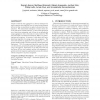204 search results - page 28 / 41 » An Organizational Design for Adaptive Sensor Networks |
ICDCSW
2009
IEEE
14 years 2 months ago
2009
IEEE
—The number of active nodes in a WSN deployment governs both the longevity of the network and the accuracy of applications using the network’s data. As node hibernation techniq...
SENSYS
2003
ACM
14 years 24 days ago
2003
ACM
Simple in-network data aggregation (or fusion) techniques for sensor networks have been the focus of several recent research efforts, but they are insufficient to support advance...
PERCOM
2009
ACM
14 years 2 months ago
2009
ACM
—One part of the vision of ubiquitous computing is the integration of sensing and actuation nodes into everyday objects, clothes worn on the body, and in large numbers into the e...
KBSE
2007
IEEE
14 years 1 months ago
2007
IEEE
Growth in the complexity of computing systems, in the dynamism of the environments they operate in, and the need for timely adaptations as conditions change, now pose significant...
IPSN
2004
Springer
14 years 27 days ago
2004
Springer
The efficacy of data aggregation in sensor networks is a function of the degree of spatial correlation in the sensed phenomenon. While several data aggregation (i.e., routing with...

